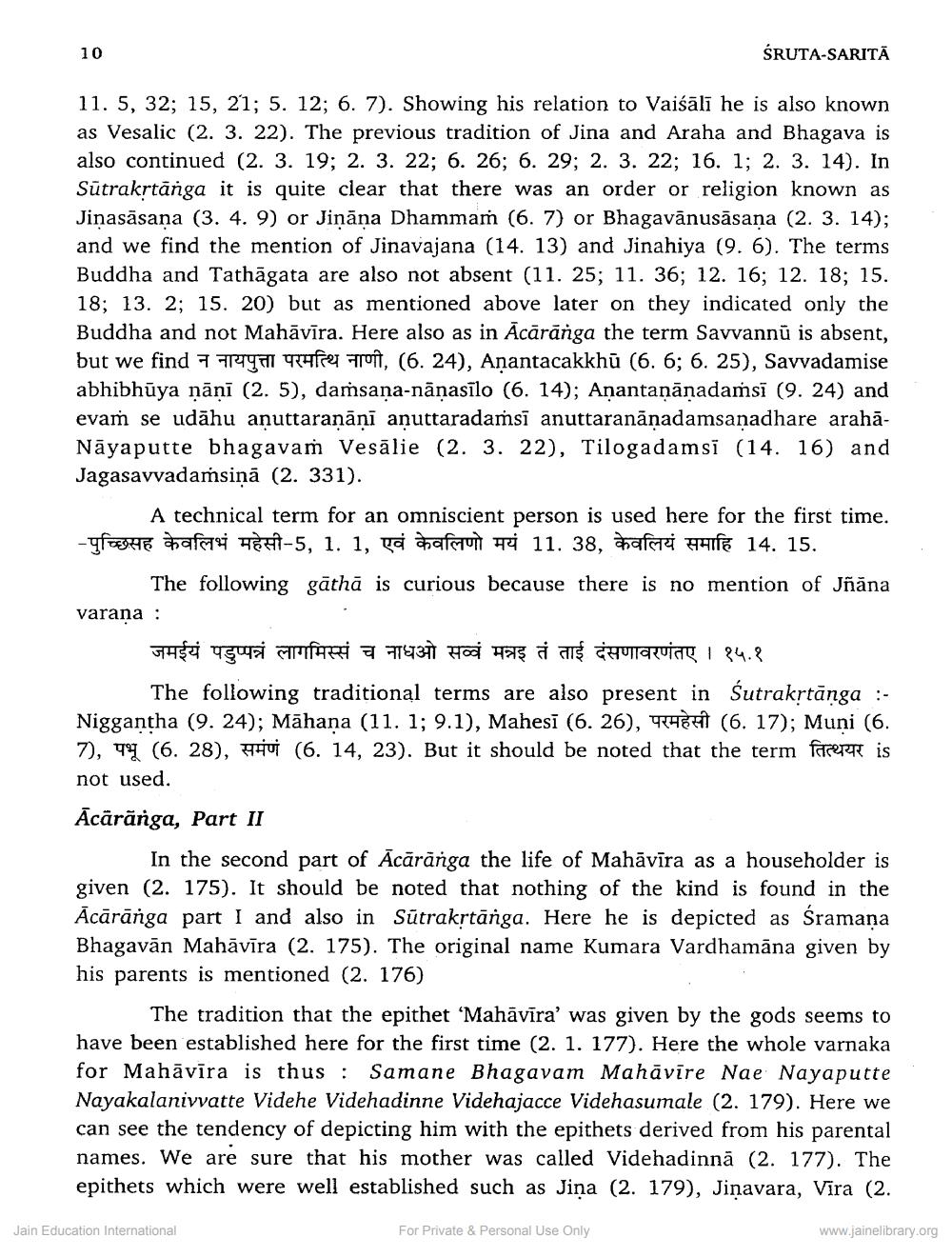________________
10
ŚRUTA-SARITĀ
11. 5, 32; 15, 21; 5. 12; 6. 7). Showing his relation to Vaiśālī he is also known as Vesalic (2. 3. 22). The previous tradition of Jina and Araha and Bhagava is also continued (2. 3. 19; 2. 3. 22; 6. 26; 6. 29; 2. 3. 22; 16. 1; 2. 3. 14). In Sūtrakstānga it is quite clear that there was an order or religion known as Jinasāsana (3. 4. 9) or Jināna Dhammam (6. 7) or Bhagavānusāsana (2. 3. 14); and we find the mention of Jinavajana (14. 13) and Jinahiya (9. 6). The terms Buddha and Tathāgata are also not absent (11. 25; 11. 36; 12. 16; 12. 18; 15. 18; 13. 2; 15. 20) but as mentioned above later on they indicated only the Buddha and not Mahāvīra. Here also as in Ācārānga the term Savvannü is absent, but we find 7 7744 Rue Front, (6. 24), Anantacakkhū (6. 6; 6. 25), Savvadamise abhibhūya nāni (2.5), damsana-nāṇasīlo (6. 14); Anantanānadamsī (9. 24) and evam se udāhu anuttaranāni anuttaradamsi anuttaranāņadamsanadhare arahāNāyaputte bhagavam Vesālie (2. 3. 22), Tilogadamsi (14. 16) and Jagasavvadaṁsinā (2. 331).
A technical term for an omniscient person is used here for the first time. -Foghe Safe HEH-5, 1. 1, ya dafut 11. 38, Hafstei hf 14. 15.
The following gāthā is curious because there is no mention of Jñana varana :
जमईयं पड़प्पन्नं लागमिस्सं च नाधओ सव्वं मन्नइ तं ताई दंसणावरणंतए । १५.१
The following traditional terms are also present in Sutrakrtānga :Niggantha (9. 24); Māhana (11. 1; 9.1), Mahesī (6. 26), 2464 (6. 17); Muni (6. 7), 79 (6. 28), V (6. 14, 23). But it should be noted that the term forrerate is not used.
Acarõnga, Part II
In the second part of Ācāranga the life of Mahāvīra as a householder is given (2. 175). It should be noted that nothing of the kind is found in the Ācārānga part I and also in Sūtrakrtānga. Here he is depicted as Sramana Bhagavān Mahāvīra (2. 175). The original name Kumara Vardhamāna given by his parents is mentioned (2. 176)
The tradition that the epithet ‘Mahāvīra' was given by the gods seems to have been established here for the first time (2. 1. 177). Here the whole varnaka for Mahāvīra is thus : Samane Bhagavam Mahāvīre Nae Nayaputte Nayakalanivvatte Videhe Videhadinne Videhajacce Videhasumale (2. 179). Here we can see the tendency of depicting him with the epithets derived from his parental names. We are sure that his mother was called Videhadinnā (2. 177). The epithets which were well established such as Jina (2. 179), Jinavara, Vira (2.
Jain Education International
For Private & Personal Use Only
www.jainelibrary.org




